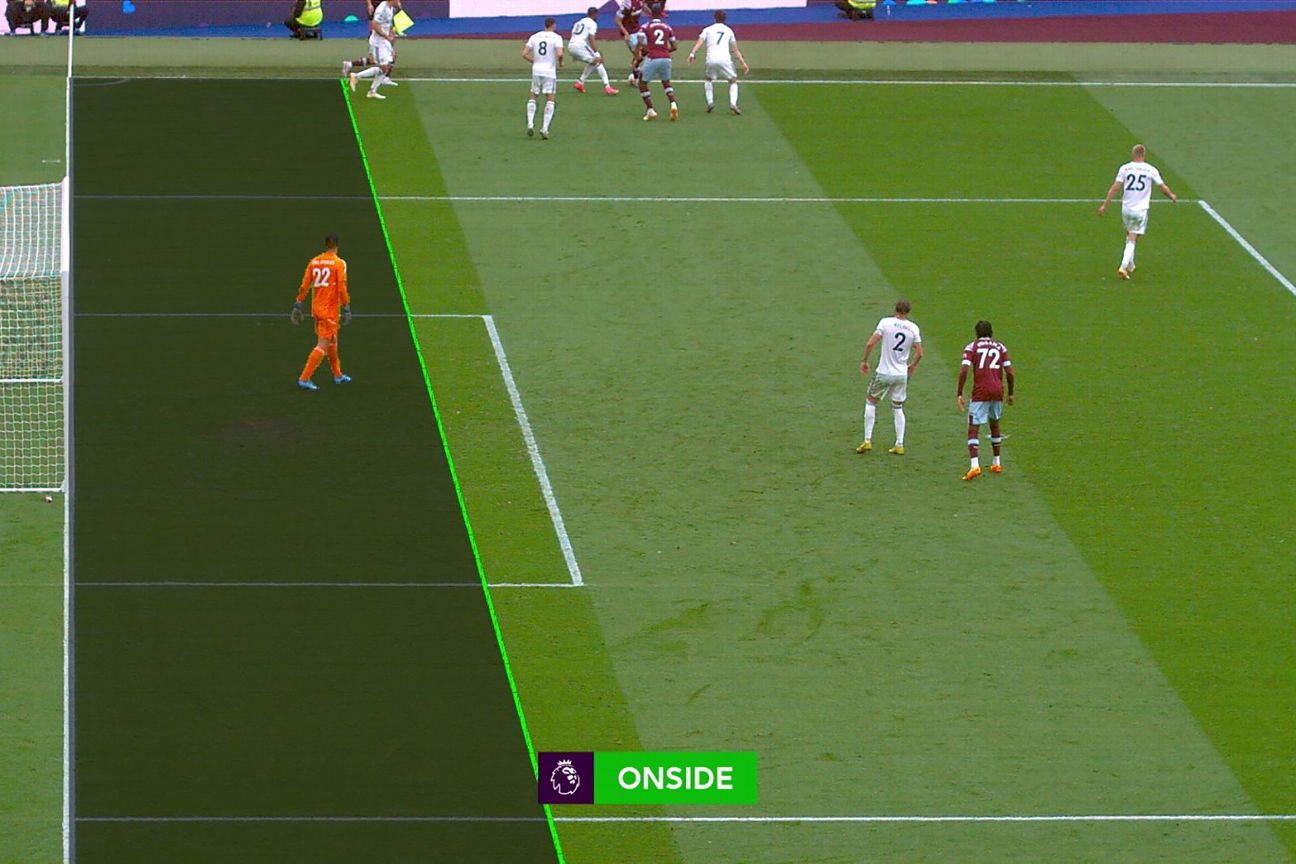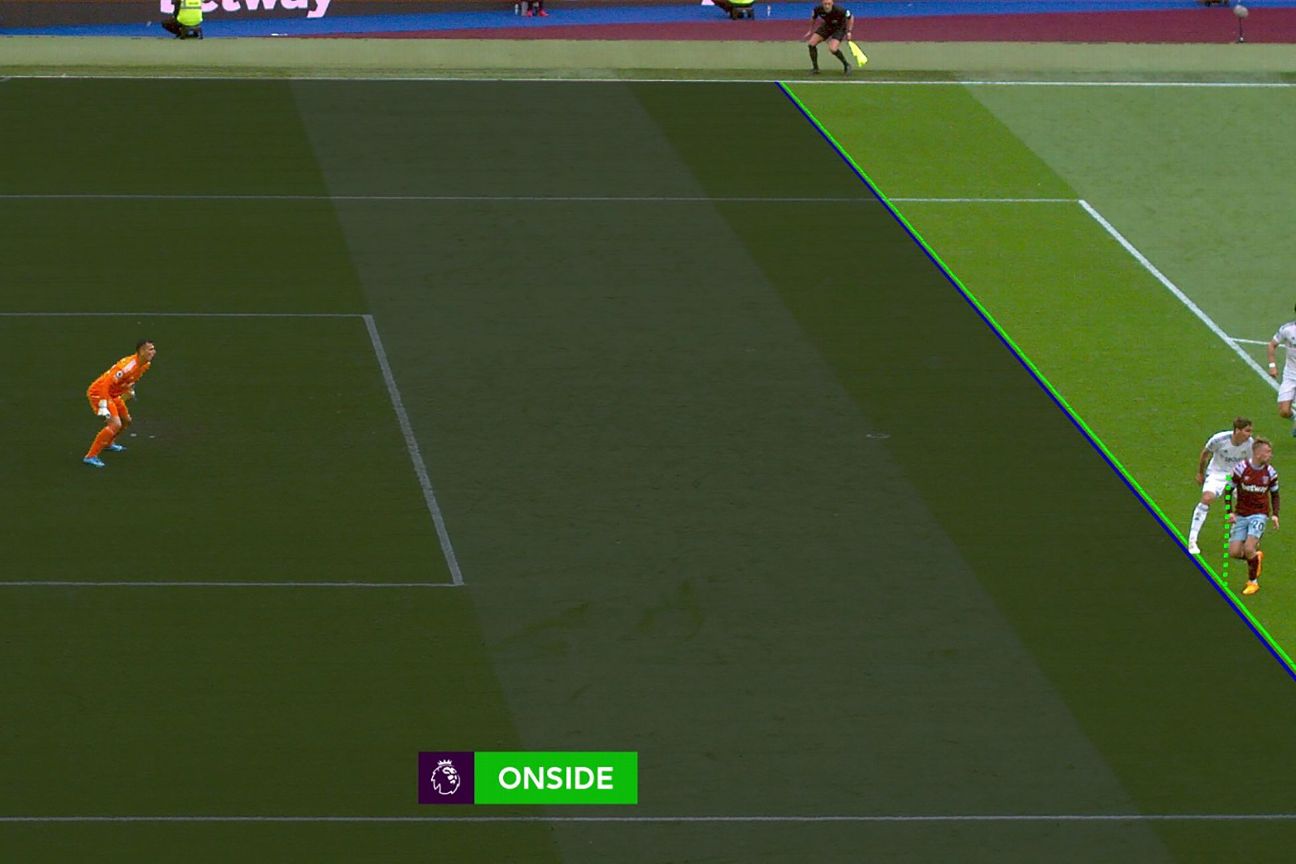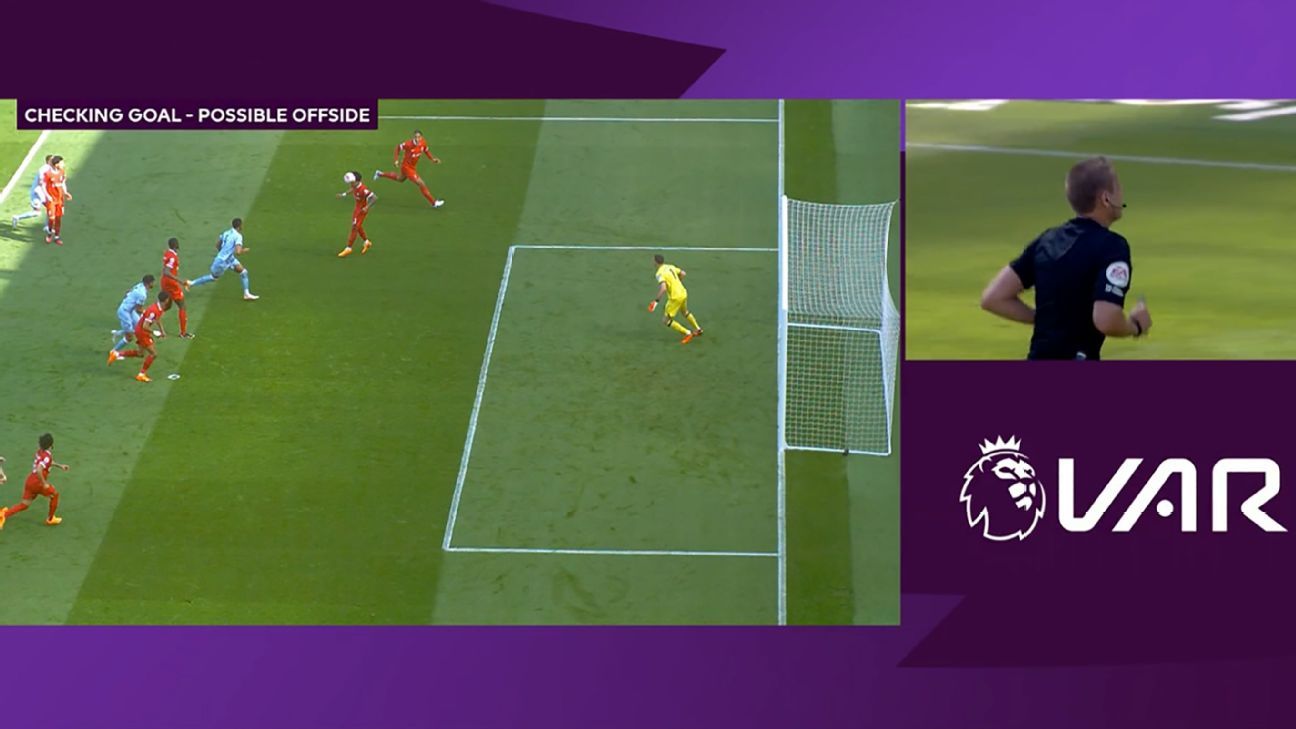Video Assistant Referee causes controversy every week in the Premier League, but how are decisions made, and are they correct?
After each weekend we take a look at the major incidents, to examine and explain the process both in terms of VAR protocol and the Laws of the Game.
– How VAR decisions affected every Prem club in 2022-23
– VAR in the Premier League: Ultimate guide
In this week’s VAR Review: A look at Liverpool‘s disallowed goal against Aston Villa, a possible red card for Tyrone Mings on Cody Gakpo, and Jordan Henderson‘s penalty claim in the same game. Also, should Arsenal striker Gabriel Jesus have been awarded a penalty at Nottingham Forest?
Possible offside: Van Dijk before Gakpo goal
What happened: With Villa 1-0 up, Liverpool equalised in the 54th minute. Trent Alexander-Arnold swung a ball in which Luis Diaz attempted to head back across the box. It came off Aston Villa defender Ezri Konsa, fell to Virgil van Dijk, and after a short melee Cody Gakpo fired into the net. But there was a check for offside in the buildup.
VAR decision: Goal disallowed.
VAR review: Firstly, the direction the ball travels isn’t relevant for an offside; it can be played forwards, backwards or square. So with Van Dijk ahead of the ball when Diaz nods it backwards, the Netherlands international is active.
It means that unless Konsa makes a “deliberate play” of the ball, to reset the phase, Van Dijk has to be offside.
When the IFAB clarified the guidelines around a “deliberate play” at the start of the season, the intention was to end the controversy over players gaining an advantage from being in an offside position. But — as has been the case with most law revisions in recent years — it created an overcomplicated layer of subjectivity which leads to goals such as this being disallowed.
Was Konsa deliberately trying to play the ball? Yes. Was it a “deliberate play” of the ball by Konsa? Not necessarily. It’s clumsy wording from the lawmakers, because this is about a player being in control of their actions and the outcome. It doesn’t excuse a defensive error, but it does mean an attacker should not be able to benefit if the defender has made a reflex action.
A “deliberate play” is when a player has control of the ball with the possibility of:
– passing the ball to a teammate;
– or gaining possession of the ball;
– or clearing the ball (e.g. by kicking or heading it.)
The ball came at Konsa from a short distance and was dropping behind him until he attempted to get his foot on the ball, while it came off his knee to run to Van Dijk.
Another of the clauses for a “deliberate play” requires Konsa to have “time to coordinate their body movement, i.e. it was not a case of instinctive stretching or jumping, or a movement that achieved limited contact/control,” and it’s hard to argue that he did. Konsa can’t realistically have any kind of control over the destination of the ball when it hits his knee. The Independent Key Incidents Panel is very unlikely to rule this as a mistake with the ball not coming off the foot.
It’s correct in law, even if it’s one that many people will be unable to get on board with. If the goal had been given, it probably wouldn’t have been questioned by anyone other than those with a deep knowledge of this area of the offside law, which has become needlessly complicated in the search for simplicity; it’s the kind of decision which wouldn’t be helped by hearing the VAR audio from Tony Harrington.
In March, Newcastle United had an Elliot Anderson goal disallowed at Nottingham Forest when Sean Longstaff was ruled to be offside with Felipe not having made a deliberate play. That was an exceptionally borderline call, and the VAR shouldn’t have got involved. The Independent Key Incidents Panel ruled it was an incorrect intervention, too.
Felipe was facing the ball, had a good view of it and made a movement to stop a cross, but only managed to divert the ball toward Longstaff with his boot. But this Liverpool incident is different and more along the lines of the goal Manchester United had ruled out against Reading in the FA Cup when Thomas Holmes made involuntary movement to stop a pass.
There was a similar incident in Germany in February. RB Leipzig‘s Yussuf Poulsen had an equaliser disallowed in a 2-1 defeat at Union Berlin, with a defender inadvertently flicking a ball to an offside Timo Werner in the buildup to the goal. Werner came back to receive the ball, it was ruled not to be a deliberate play and the goal was ruled out.
An Anfield, the referee had to go to the monitor as it was subjective and he must make the call on the “deliberate play” aspect.
Also, there was a question of a possible handball by Gakpo before scoring, but the ball came off his chest.
Possible red card: Mings challenge on Gakpo
What happened: In first-half injury time, Tyrone Mings challenged Gakpo for the ball and caught the Liverpool player in the stomach. Referee John Brooks showed the Villa player the yellow card.
VAR decision: No red card.
VAR review: In the Premier League, there tends to be much greater leniency when it comes to high boots — unless there is any force and intensity in the challenge.
Earlier this season the VAR took no action when Manchester City striker Erling Haaland caught Crystal Palace‘s Joachim Andersen with a high foot. And at the end of April, Diogo Jota made contact with the head of Tottenham Hotspur‘s Oliver Skipp in similar fashion.
In both those cases, the Independent Key Incidents Panel ruled the VAR was correct not to advise a red card, but the Mings incident is likely to be a missed red card.
Haaland and Jota could both be explained by the players not being aware of the position of their opponent, who had lowered their heads. But Mings has to know where Gakpo is and his boot appears to follow through into the opponent’s chest.
The referee saw the studs make contact with the chest and didn’t feel there was force in the challenge, so Harrington decided the yellow card was an acceptable disciplinary outcome.
Harrington was also the VAR when the yellow card shown to Crystal Palace goalkeeper Sam Johnstone at Wolverhampton Wanderers wasn’t changed to red, a decision the Independent Match Incidents Panel recorded as a missed intervention.
The Johnstone incident came with more force, with the player out of control in his challenge, but Mings is very lucky that the VAR didn’t see this as an error not to show a red card.
Possible penalty: Luiz challenge on Henderson
What happened: Deep into first-half stoppage time, Mohamed Salah played the ball to Jordan Henderson on the edge of the area and went to ground under a challenge from Douglas Luiz. Harrington began a check for a possible penalty.
VAR decision: No penalty.
VAR review: We’ve seen this consistently with VAR decisions in the Premier League this season, with penalties not awarded when a small amount of contact leads to a player going to ground in a way that doesn’t fit.
Luiz does make contact with Henderson’s ankle, but does that cause the Liverpool player to go to ground in the way he has? Or does he use that contact to try to win the penalty?
Liverpool fans will point to the penalty awarded to Kevin De Bruyne after minimal contact from Fulham left-back Antonee Robinson earlier in the season — the difference being that penalty was awarded by the referee, and not the VAR. It’s example of how the consistency with VAR is about the point of intervention, and not making all decisions on the pitch the same — as they are judged in the eyes of the referee’s subjectivity.
The one time the VAR did get involved when there was minimal contact, to award a penalty to Brentford against Newcastle United, the Independent Key Incidents Panel ruled that to be an incorrect intervention.
Possible penalty and red card: Worrall holding on Jesus
What happened: In the 54th minute, Gabriel Jesus went to ground claiming he had been pulled back by Joe Worrall. The ball ran through to Nottingham Forest goalkeeper Keylor Navas and referee Anthony Taylor turned down appeals for a penalty. The VAR, Neil Swarbrick, checked for a possible penalty and/or red card.
VAR decision: No penalty or red card.
VAR review: The VAR has two things to consider when assessing this. The first is the position of the possible foul and the alleged pull back. It looks as though it’s just outside the area when Worrall removes his arm from Jesus, which means this cannot be a penalty.
That doesn’t rule out the possible role of the VAR. If he thinks the defender has denied a clear goal-scoring opportunity, he could still advise a red card — which would result in a free kick to Arsenal on the edge of the box. However, there is no certainly that Jesus would have been able to receive and control the pass from Ben White, let alone have a clear scoring chance, so there’s no red card.
If the VAR had judged the contact to be inside the area, there’s still a question over how Jesus goes to ground in a theatrical manner, throwing his arms up. This is always taken into account for a VAR intervention. Does Worrall just have his hand on the attacker’s shoulder, or does he actually pull his opponent too?
The Arsenal striker was then booked for dissent, and not for simulation.
Possible offside: Lanzini in build up to goal
What happened: West Ham made sure of the points in the 94th minute when Lucas Paqueta set up Manuel Lanzini to score from close range. However, there was a possible offside against Lanzini earlier in the move.
VAR decision: Goal stands.
VAR review: To the naked eye this seemed likely to be ruled out for offside, but it came down to two things: the angle of the camera and the raised boot, as well as the tolerance level within this offside technology.
Because of inaccuracies within the system, around the kick point and the plotting of body position, there is a 5cm tolerance level to give the attacker the benefit of the doubt — and it’s this which meant the goal could stand.
When it’s this close, with the attacking and defending offside lines touching, or overlapping, only a single green line is displayed to the defender.
It is likely that under the older system, with no tolerance level, this would have been offside.

It was the second VAR offside decision which had gone in West Ham United‘s favour, with Jarrod Bowen ruled onside for his team’s second goal. The assistant gave the goal, confirmed by the VAR.

Possible handball: Mahrez before creating Alvarez goal
What happened: City thought they had a second goal in the 71st minute when Riyad Mahrez played in Julian Alvarez to score, but there was a check for a possible handball in the buildup.
VAR decision: Goal disallowed.
VAR review: A simple decision for the VAR, John Brooks, and possibly the quickest-ever pitchside monitor review from referee Michael Oliver.
Mahrez very clearly leant into the ball and controlled it with his arm, before going on to create the goal.
Mahrez wasn’t the scorer, but the handball being a deliberate act in the attacking phase makes it an offence. It was the correct call to disallow the goal.
Possible offside: Ward before scoring
What happened: Crystal Palace equalised in the 83rd minute when Joel Ward scored, but was he offside after the ball bounced around the box?
VAR decision: Goal stands.
VAR review: When Michael Olise took the free kick, Ward and the rest of the Palace attack were in an onside position. So, the ball would have to be touched by another Palace player to create a new offside phase.
The ball missed Palace’s Jean-Philippe Mateta, then deflected off Fulham defender Antonee Robinson, and it ran through to Ward.
If the ball had touched Mateta first before Robinson, then Ward would have been offside. But it didn’t, and a phase of offside is only created by each pass or touch by an attacking player, and not a defender.
Information provided by the Premier League and PGMOL was used in this story.
